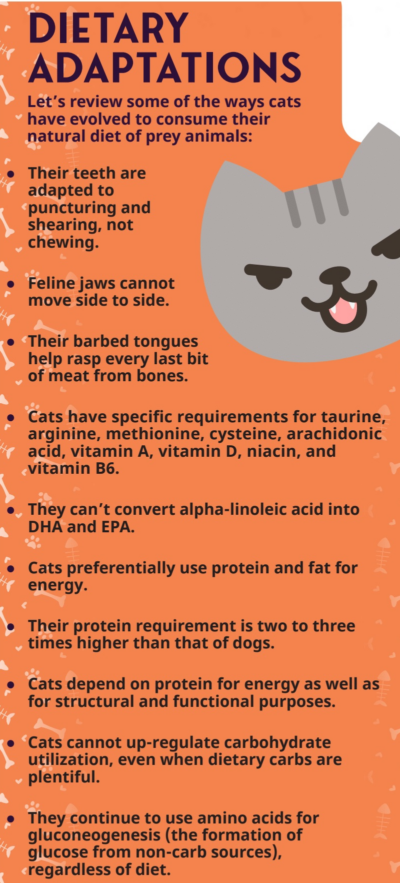Diet plays a significant role in the health and longevity of our feline friends. Feeding them in a way that aligns with their natural instincts can help prevent obesity and other health problems. In this article, we will explore the optimal diet for cats, the feeding problems that can lead to obesity, and effective ways to keep your cat lean and healthy throughout her life.
BUILD A BETTER MOUSE?
It is common sense to feed cats a diet that closely resembles what they would eat in the wild. However, studies have also confirmed this theory. Researchers have discovered that cats prefer foods that mimic their natural prey, consisting of approximately 55% protein, 40% fat, and 5% carbohydrate on a dry matter basis. This composition is similar to that of a can of kitten food or a well-formulated homemade or raw diet. It also aligns with the diet of feral cats.
While we can recreate a diet that resembles a mouse, there is one crucial element missing: blood. Blood is rich in protein, iron, lipids, amino acids, minerals, sugars, fats, hormones, and vitamins. When a cat kills a mouse, she consumes the entire prey, including the blood. Unfortunately, we cannot replicate this lost vitality when slaughtering animals for consumption. However, we can help cats maintain mental and physical fitness by providing environmental enrichment, interactive play, and reducing their overall caloric intake.
“CHONKY CATS” — NOT CUTE, NOT FUNNY
You may have noticed the rise in popularity of “chonky” cats on social media. Sadly, this trend reflects a growing problem. Over 60% of adult cats are overweight or obese, which can lead to various serious conditions such as arthritis, chronic digestive issues, allergies, diabetes, skin disease, urinary tract problems, liver disease, cancer, and heart, liver, and kidney issues. It is crucial to focus on preventing obesity rather than treating it. However, several factors make maintaining a healthy weight challenging:
Decreased metabolic need after neutering
Neutered cats require 25% to 30% fewer calories compared to intact cats. Hormones in intact cats help preserve lean muscle and keep their activity levels high. Combining reduced metabolic needs with a less stimulating environment can result in a fat cat. To combat this, provide environmental enrichment, interactive play, and reduce caloric intake starting as early as possible in your cat’s life.
Excess carbohydrates
Most commercial dry cat foods contain 30% to 50% carbohydrates, which cats have no physiological need for. Unused dietary carbohydrates are stored as fat. Weight loss diets high in fiber can increase dehydration and reduce protein digestibility, resulting in a loss of lean body mass and a reduced basal metabolic rate. This makes it more challenging for cats to lose weight and maintain it, even on a reduced-calorie diet.
Constant food availability
Cats are not grazers by nature and should not have constant access to food. Unfortunately, many people leave poor-quality dry food out all day, every day. In the wild, cats would catch multiple small prey in a 24-hour period. To mimic this natural feeding behavior, it is better to provide timed meals for your cat. Consider feeding smaller meals more frequently, allowing 30 to 60 minutes of food availability, and removing the food at all other times. A three-meal-a-day schedule, such as morning, after school or work, and before bed, can work well for most people. Engaging in interactive play before the evening meal can also help cats sleep through the night without demanding breakfast at the crack of dawn.
KEEPING CATS LEAN AND HEALTHY
To help prevent obesity and ensure your cat’s well-being, it is essential to feed her a high-protein, high-moisture, and very low-carbohydrate diet. This type of diet closely resembles the composition of their natural prey and reduces the likelihood of weight gain. If your cat needs to lose weight, this diet will also help her retain lean body mass.
Additionally, consider feeding your cat in timed meals rather than leaving food out all the time. Try to provide smaller, more frequent meals, allowing food availability for specific time intervals and removing it at other times. A three-meal-a-day schedule can be effective for most cat owners. Incorporating interactive play sessions before the evening meal can also help cats sleep through the night without demanding breakfast too early.
By educating yourself about the ideal diet for cats and providing them with high-protein, low-carbohydrate food, you can help your feline friend maintain a healthy weight and overall well-being. If your cat is already at a healthy weight, this type of diet will help keep her lean and vibrant.
For more information on pet care and health, visit Pet Lovers Diary.
Source link: The Best Diet for Preventing Obesity in Cats
